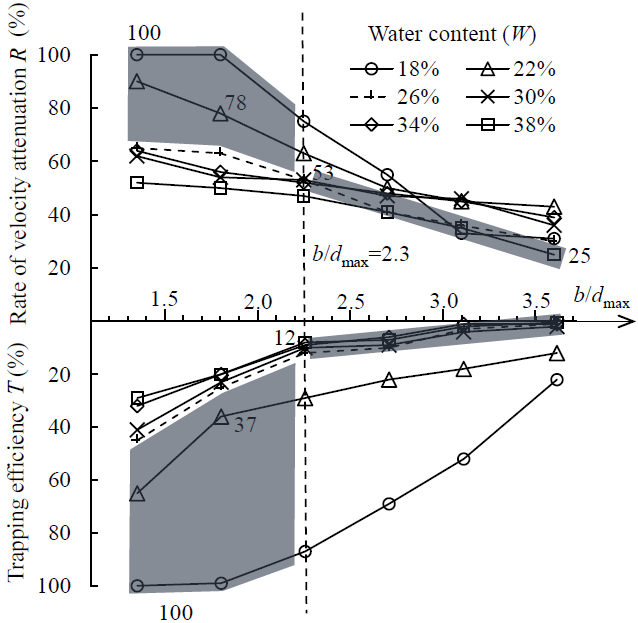Finding the reasonable post spacing (b) of slit dam is fundamental and vital for the design of slit dam to constrict the flow and to attenuate the kinetic energy of debris flows, and to prevent the slit dam from being easily filled up because of their non-selective retention. Prof. ZhOU Gongdan and his research group from the Institute of Mountain Hazards and Environment, Chinese Academy of Sciences conduced physical model tests with a 7-m-long flume to study the regulation function of slit dams against debris flows at varying water contents of debris flows (W) and the relative post spacing (b/dmax) of slit dams.
Results reveal that the velocity attenuation and trapping efficiency is strongly controlled by water content and relative post spacing. Water content fundamentally reflects the degree of liquefaction (effetive grain-contact stress) and capacity of energy dissipation of debris flows. When water content < 26%, the relative post spacing has a noticeable effect on velocity attenuation, trapping efficiency, and run-out distance. In contrast, when water content ≥ 26%, the influence of relative post spacing is negligible. Furthermore, a new relationship between velocity attenuation and trapping efficiency for the design of slit dams is proposed to avoid the slit dam being easily filled up by sediments contained in debris flows. Namely, when W ≥ 26%, the slit dam is recommended with a relative post spacing between 2.3 and 3.6, which provides velocity attenuation of 25% to 53% with trapping efficiency from 0 to 12%.
This study has been supported by the National Natural Science Foundation of China (grant No. 11672318), and the Youth Innovation Promotion Association of Chinese Academy of Sciences.
This study entitle Experimental study on the regulation function of slit dam against debris flows has been published online in Landslides.

Figure1. Comparison between rate of velocity attenuation R and trapping efficiency T at varying water content and relative post spacing (b/dmax) (Image by ZHOU Gongdan).
Contact:
Dr. ZHOU Gongdan
Institute of Mountain Hazards and Environment, Chinese Academy of Sciences
Chengdu, Sichuan, 610041, China
Tel: 86-13980660182
E-mail: gordon@imde.ac.cn

